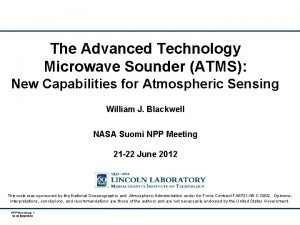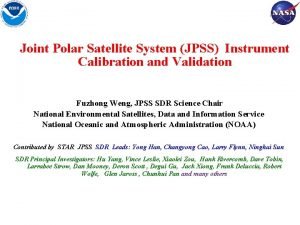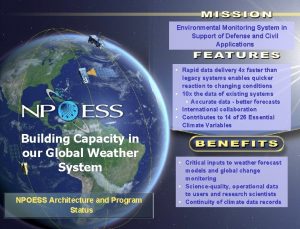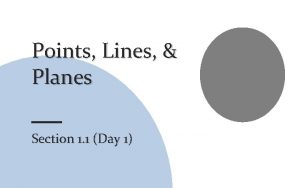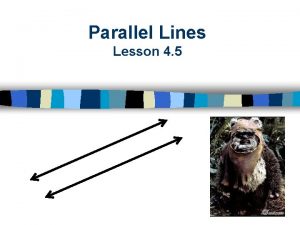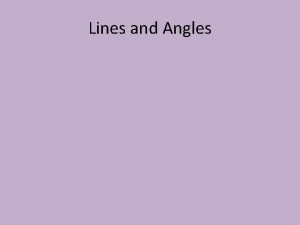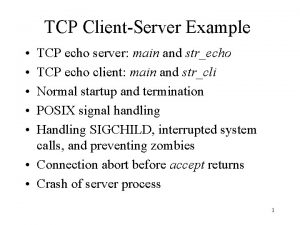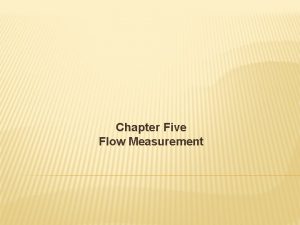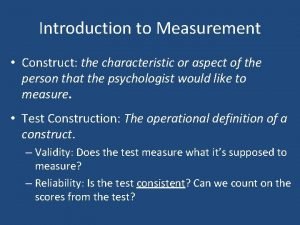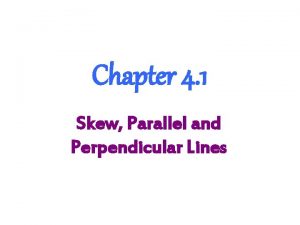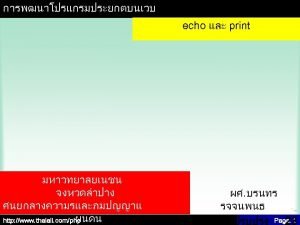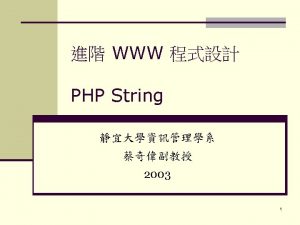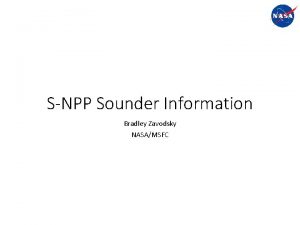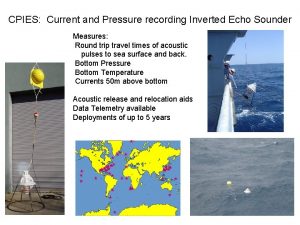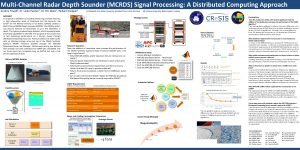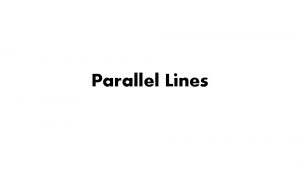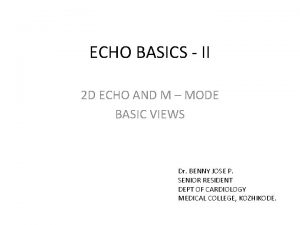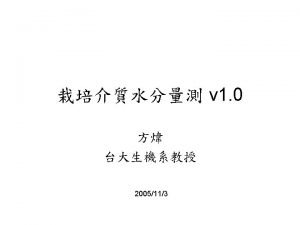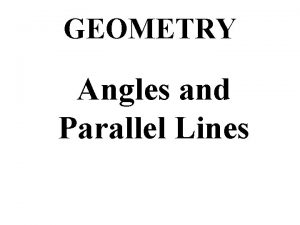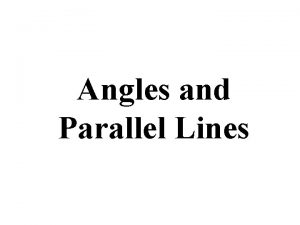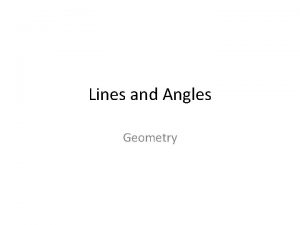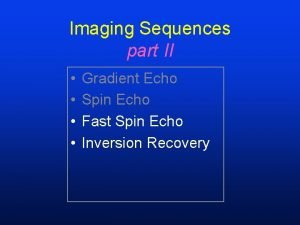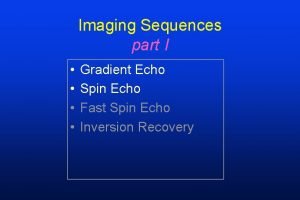Lead lines and Echo sounder Introduction Depth measurement























- Slides: 23

Lead lines and Echo sounder

Introduction • Depth measurement could be done by two ways one is mechanical another one is electronic. • The Lead Line is the oldest navigational instrument and was used by the ancient Egyptians. Lead lines are used in shallow waters even today by traditional fishermen in different parts of the world. • The lead line is also called as hand lead line, is the oldest and most reliable depth-finding device for shallow waters. • Lead line is for taking soundings (which means measuring the depth of water) up to 20 fathoms ( 120 feet). • But the deep sea lead line is used to measure depth up to 100 fathoms or more. • The principle of lead line is very simple. • A weight (generally lead) is lowered to the sea bed by a graduated line. • The length of rope immersed gives the depth measurement of water.

Construction of lead line Hand lead line • Tapered bar of lead weighing from 7 to 20 pounds attached to a graduated rope. • Long rope is marked with strips of cloth and leather to indicate the various depths. • Cavity in the bottom of the tapered bar of lead is filled with a hard waxy substance when the lead touches the sea-bed. • soil gets stick in the waxy material in the cavity and useful to identify the nature of the sea-bottom.

• The cable-laid hemp rope or nylon rope is used with the length of 25 fathoms (150 feet) and 10 mm in diameter. One end of the rope is attached with lead weight by means of eye splice. • Before marking a new lead line, it should be stretched, and thereafter mark the line before it get dried. Mark the line every fathom, (1. 83 meters) with any marking colour and number them 0, 1, 2, 3, 4 etc. • Now place the end of the eye splice on the first marking ( zero) and mark the lead -line at 2, 3, 5, 7, 10, 13, 15, 17, 20. Fathoms which correspond with the depths marked are called marks.

• There are no markings at 1, 4, 6, 8, 9, 11, 12, 14, 16, 18 and 19 fathoms. These are called “Deeps”. There altogether nine marks and eleven deeps. • Different types of materials are used for marking, such as leather, linen, bunting, serge and cord. elastic nature of the rope used for a lead line. • The cable-laid rope of cotton or manila has the maximum elasticity amongst all types of ropes. Hence a cable-laid rope is used for lead line.

Markings on Hand lead line and deep sea lead line Depth Markings 2 fathoms (3 -66 m) 2 strips of leather 3 fathoms (5. 49 m) 3 strips of leather 5 fathoms (9. 14 m) white rag (white bunting) 7 fathoms (12. 80 m) red rag (red bunting) 10 fathoms (18. 29 m) Leather strip with a hole 13 fathoms Blue serge/ same as 3 fathoms 15 fathoms White calico/same as 5 fathoms 17 fathoms (31. 09) Red bunting /same as 7 fathoms 20 fathoms (36. 58) A rope cord with 2 knots 25 fathoms (45. 72) A rope cord with 1 knots 30 fathoms (54. 86) A rope cord with 3 knots 35 fathoms (64. 01) A rope cord with 1 knots 40 fathoms (73. 15) A rope cord with 4 knots

Deep sea lead line • The lead attached with deep sea lead line is weighing from 30 to 50 pounds. • Operation of lead line • The leadsman takes his place at the bow of a boat. • Secure himself with “ breast band” (a wide strip of canvas used like a seat belt )to avoid from falling overboard. • The leadsman lean forward and swing his lead. Coil the spare line in your other hand, free for running • When you can swing the lead, and the force is great enough, • Then swing the lead in a complete circle and throw it as far forward as possible let go of the lead as it swings forward at a point about level with the deck. As the ship moves ahead, heave in the spare line rapidly. (This will facilitate the lead to resting on the bottom and the line tight, when the vessel is directly over the lead. ) • The leadsman can feel that line has reached the bottom by the sudden slack felt in the line. • Pickup the slack quickly and as the ship moves ahead, the lead will come directly under you.

Echosounder • The echosounding principles were used to detect iceberg by the Canadian engineer R. A. Fessenden in 1914. – During the World War II echosounders were played major role in detection of submarines. In 1954. • Echo sounders, also called fathometers and Depth finders are used by vessels for navigational purposes.

Development of Acoustic Methods in Fisheries • The echosounder was used for measuring the depth of water and to find the fish beneath the vessel. • When the echosounder used in fishing vessels then it is called as fish finder (also called a depth finder / sounder / Fish finder / Depth recorded ). • In fisheries the term echosounding (vertical sounding) is usually restricted to sound transmitted from a vessel and returned to it along a line straight down to the sea bed (or bottom). • The equipment employing this technique is called an ECHOSOUNDER.

Basic Principle of echosounder • Sound waves are directed in the same way as light waves in a searchlight, towards the bottom of the sea floor. • A pulse of sound sent from the ship is get reflected as echo after hitting the sea bottom. • The time interval between transmission of sound wave and the reception of bounced echo is being proportional to the depth of the water. • Water depth is determined from the travel time and the speed of sound in water. Water depth can be estimated simply by using an average sound speed and the following relationship: • Distance between vessel and sea bottom = speed of the sound wave in water multiplied by travel time of sound wave send from vessel and reception of echo by vessel divided by two. The value is divided by 2 as the sound wave travels two way from vessel to sea bed and seabed to vessel.

Sound in water • Sound waves can travel through a material medium such as a gas, a liquid or a solid, with particular speed, but not a vacuum. • Frequency number of waves or periods per second. A period is also called a cycle and frequency is sometimes expressed as cycles per second (c/s). One thousand cycles per second is one kilocycle per second (1 kc/s). The unit ‘cycle per second’ is now internationally called Hertz. • Those above the normal range of the human ear are termed ultrasonic or supersonic frequencies. • Sound velocity depends on certain physical properties of the material through which the sound travels, namely elasticity and density. In air, the sound velocity is approximately 322 m per second (m/s) at 0°C, and it increases. • In water, sound velocity is about, 1, 500 m/s at 15°C.

• Sound is partly reflected when it passes from one medium to another having different density and elasticity. The amount of reflection depends on the difference between then properties of the materials. Air and water are materials of greatly different density and elasticity and their interface or the layer at which they meet is almost a complete barrier sound. Air bubbles / rocks gives strong echos. Soft, muddy bottoms gives weaker echos. Fish with a swim bladder / air bladder give better echos than fish without, because the difference in density between the water and the gas in the swim bladder is greater than that between water and fish flesh. Regular changes in depth, salinity and temperature affect the propagation of sound.

• Echo-sounders transmit a pulse of acoustic energy down towards the seabed and measure the total time taken for it to travel through the water, i. e. the outwards and return journey. If the measured time is one second and it is known that the speed of acoustic waves is 1500 m/s, the depth is obviously (1500 x 1)/2 metres = 750 m. Similarly, the two way travel time of sound wave is 5 seconds, then the depth is 1500 x 5/2 =7500/2=3750 m.

Basic components of Echosounder • An echo sounder consists of 4 basic components. • The Transmitter • The Transducer • The Receiver • The Recorder

Block diagram of echo sounder Transmitter ← Recorder ⇄ Receiver ↖ ↗ Transducer ↓ Sound pulse ↑ Echo

Transmitter • The function of the transmitter is to produce energy in the form of pulses of electrical oscillations. • The pulses of electrical energy are generated at a specified frequency. (Frequencies for fisheries applications might be 38 KHz, 120 KHz or 400 KHz).

Transducer • Is fixed in the hull region, below the waterline of the vessel. • The main function of the transducer is to convert electrical energy into sound energy when sound is to be sent and conversely, to convert the sound energy into electrical energy when echoes are received. • The transducer is also responsible for concentrating the sound pulse in a directional beam, similar to the beam of light produced by search light.

Receivers • To amplify the weak electrical oscillations produced in the transducer by the echo so that they can be recorded or displayed. • The automatic sensitivity control is adjusted to cover the complete operational depth range of the echo sounder and to compensate for dispersion and absorption of sound within this range. The strength of a returning echo is thus independent of the depth from which it comes and dependent only on the echo target strength of the reflecting objects, such as fish or sea bottom. This type of depth adjusted automatic amplification is known as Time Varied Gain (TVG). The level of amplification automatically adjusted with the depth from which the echo is coming to the transducer.

Recorders • The recorders are responsible for displaying and recording of the echos in different forms like paper recorder, a flash-light display, an audible signal or an oscilloscope (Cathode Ray Tube ( CRT)). • Modern echosounders often use a colour monitors to show the echoes. In recent years , most advanced, light weight displays such as LCD and LED are used in echo sounders. • Colour display will clearly differentiate the echoes with varying strengths

Paper recorder • Though paper recording is very old technique, it is reliable and recordings could be saved for future reference. – Such recordings will be much useful in fish biomass estimation studies. – Paper used for echo recording could be of two types , wet paper and dry paper. • The visual record of the reflected echoes of sound transmitted by an echo sounder is known as Echo gram.

Oscilloscope (CRT) • The depth range to be studied and the scale of display can easily be varied in an oscilloscope. – The CRT display is therefore the best for the detailed study and identification of echoes, and also useful to distinguish the bottom dwelling fish echoes close from the echoes of bottom. – This could be achieved by applying a special effect called White line Technique. The White line technique is a special signal treatment in the receiver whereby echoes above a certain strength either completely block the receiver ( displayed as white line in the screen) or are presented as a faint grey recording (grey line).

Installation and maintenance of echosounders • Positioning and installation of the transducer are often decisive in ensuring proper performance. • Maintenance of tranducer of echosounder - Transmitter and receiver do not require routine maintenance - Transducer should be inspected and its surface to be cleaned whenever possible - Transducer face must be kept free from growth of seaweed or fouler in order to function properly. - Scratching of surface with hard sharp instrument will damage the soft parts, so use only wood pieces for cleaning the surface of transducer. - Do not paint the transducers face • Fish detection at depths greater than 500 m requires high transmission power, a narrow beam and medium or low frequency. This will be the costlier and sophisticated instrument.

Points to be remembered while operating echosounders • Select high operating frequency of the sounder in shallow waters and low frequency in deeper waters • Short pulse length would give better vertical resolution of the echoes • For greater depth select long pulse length and narrow band width • For shallow waters short pulse length and wide beam width
 Echo sounder block diagram
Echo sounder block diagram![[-n $home] 2 echo $? 3 [-z shome] 4 echo $? [-n $home] 2 echo $? 3 [-z shome] 4 echo $?](data:image/svg+xml,%3Csvg%20xmlns=%22http://www.w3.org/2000/svg%22%20viewBox=%220%200%20200%20200%22%3E%3C/svg%3E) [-n $home] 2 echo $? 3 [-z shome] 4 echo $?
[-n $home] 2 echo $? 3 [-z shome] 4 echo $? Total internal reflection semicircular glass block
Total internal reflection semicircular glass block Advanced technology microwave sounder
Advanced technology microwave sounder Advanced technology microwave sounder
Advanced technology microwave sounder Advanced technology microwave sounder
Advanced technology microwave sounder Lead magnesium niobate
Lead magnesium niobate Echo and narcissus questions and answers
Echo and narcissus questions and answers Points lines planes worksheet
Points lines planes worksheet Lines are lines that never touch and are coplanar
Lines are lines that never touch and are coplanar Break line engineering
Break line engineering Parallel lines def
Parallel lines def What is the central theme of echo and narcissus
What is the central theme of echo and narcissus Tcp echo server and client in network programming
Tcp echo server and client in network programming Allusions in act 3 of romeo and juliet
Allusions in act 3 of romeo and juliet Flow measurement introduction
Flow measurement introduction Introduction to measurement
Introduction to measurement Can skew lines be parallel
Can skew lines be parallel Kraissl lines vs langer lines
Kraissl lines vs langer lines Horizontal line art definition
Horizontal line art definition Plane geometry real life example
Plane geometry real life example Rýmové echo
Rýmové echo Nrga in echo
Nrga in echo Los tres grandes
Los tres grandes
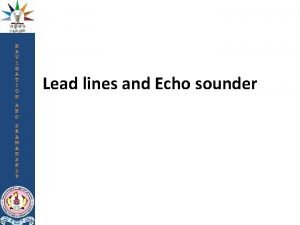
![[-n $home] 2 echo $? 3 [-z shome] 4 echo $? [-n $home] 2 echo $? 3 [-z shome] 4 echo $?](https://slidetodoc.com/wp-content/uploads/2021/03/4520173_09339f8d6296694d67adb66823cc7f1f-300x225.jpg)

